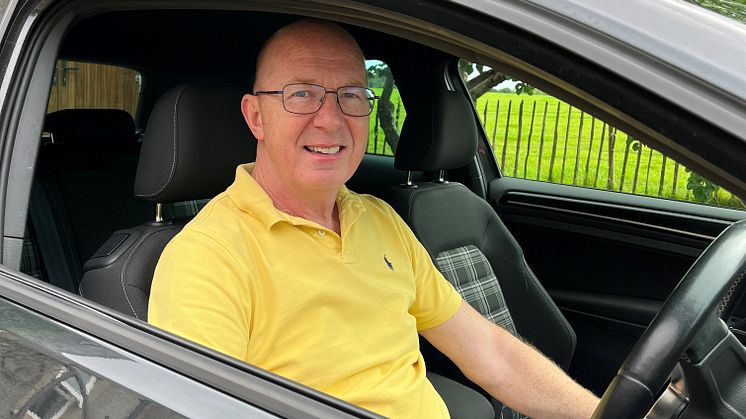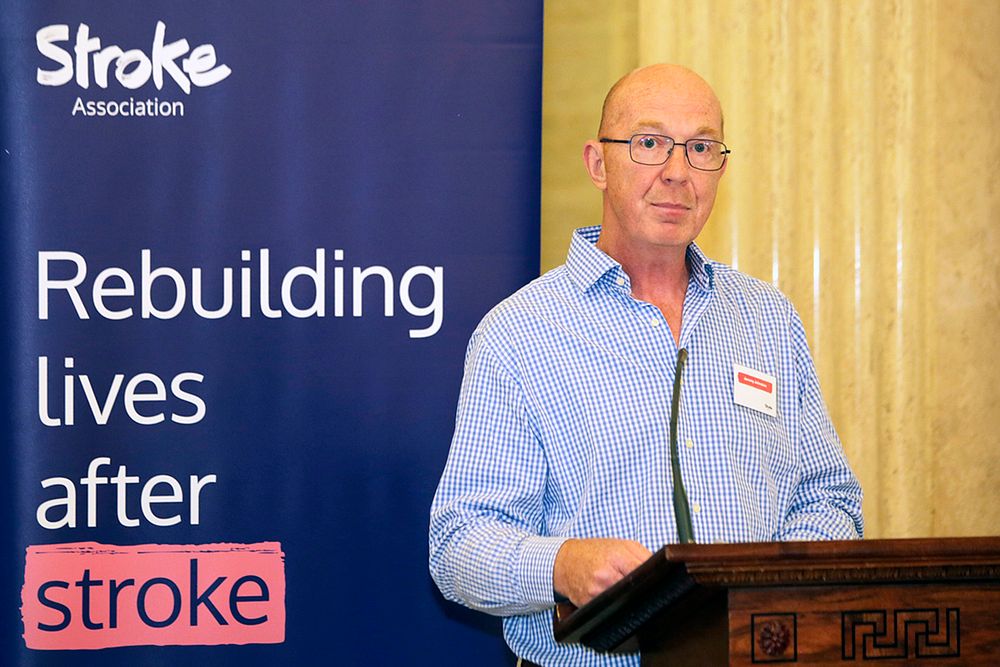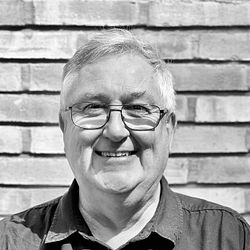
Press release -
Little-known rule offers hope of driving for stroke survivors who lose peripheral vision
Jeremy Johnston was devastated when hemianopia – the loss of peripheral vision after his stroke – meant that he was no longer able to drive.
For four years he had to accept this, but thanks to twitter exchanges with former Australian rugby captain Michael Lynagh and a Liverpool University orthoptist, then a chance encounter with a stroke specialist in a Bulgarian ski resort, he’s back behind the wheel.
A little-known rule means that stroke survivors with hemianopia are allowed to drive if they can prove that they have adapted to their vision loss.
He’s now campaigning to make all stroke survivors in a similar situation aware of the Exceptional Cases Driving Rule.
Here he tells his story in his own words.
My horrifically painful headache turned out to be a stroke
My name is Jeremy Johnston and I am an ex-Technology and Design teacher from Hillsborough, Northern Ireland, who retired early and suddenly at the age of 54 in 2017. I now spend a lot of my time in my home workshop repairing cricket bats for all comers. I am married to Alison, also now a retired teacher, and we have two grown up children.
I will take you back to 31 March, 2017 – a Thursday night, a normal bedtime in spite of a very difficult and stressful day at work. I wakened at 1am on the Friday morning with a severe headache, thought this must be my first migraine, as I wasn’t used to headaches. I tried to get back to sleep but it was impossible. The pain was horrific, but I didn't realise how significant it was and that I should take action.
I wakened Alison at approximately 4am. She said I was agitated and restless but otherwise coherent and able to move as normal. I took two paracetamol and tried again to sleep but it was no good.
By 7am the pain had eased and I asked Alison to give me my mobile to phone school to tell them that I couldn't come into work. Alison said that when she held the phone out to me, I couldn’t see it initially, but when I did see it, I put my hand out to get it and I missed it. This was the first realisation that something was wrong, but again, we were both thinking that migraines can adversely affect vision. Stroke was never on the radar. It may seem strange, but I never associated severe pain with a stroke either.
Alison phoned our brother-in-law and asked him to take me to A&E as she absolutely had to go to work – it was a big day in her school calendar that she couldn't miss.
At Lagan Valley Hospital things moved swiftly and efficiently. The care was excellent. They did a CT scan and diagnosed a right occipital CVA with loss of left sided peripheral vision, known as a hemianopia. This seemed to be the only physical impact. The team was preparing to send me via ambulance to the Royal Victoria Hospital for a clot retrieval procedure.
However, I was then informed that a decision had been made by the medical teams at both hospitals that it was too late for this procedure because I couldn't say with any certainty at what time the stroke had occurred and, in all likelihood, the damage to my vision was already permanent.
We were utterly devastated that nothing could be done, and that this vision loss now seemed to be my lot.
In shock, I was admitted to the stroke ward at the Lagan Valley at around teatime. I came under the care of a young stroke consultant. A few days later I was discharged with some understanding of what appeared to be my only deficit - my peripheral vision loss. There had been a lot of information to absorb and I was still in shock.
My stroke and its emotional effects
Shock turned to devastation as the full impact started to sink in. My emotions were all over the place. I knew that my career was likely to be over, as I couldn’t safely supervise children in a classroom, let alone a technology workshop. I also knew that driving may be an issue. During my few days in hospital, I didn't really get to sample many of the challenges that my left peripheral vision loss would present. It would be a steep learning curve.
Nevertheless, I was utterly determined to get going again, physically and emotionally but the thought of losing the ability to drive began to have a huge impact on me. No-one had really addressed it with me or spoken with any certainty about what the future held in terms of retaining my licence. It was nothing but a huge question mark, right at the forefront of my mind.
Care and recovery
I had not had any referral to any clinician regarding my vision loss and I felt I wanted to know where I stood. I instigated an appointment for a field of vision test with a friend who was an optometrist. I came away understanding properly for the first time that my peripheral vision loss affected both eyes and that I did not meet the field of vision requirements for the Driver and Vehicle Agency (DVA). Unless there were improvements then driving would definitely not be possible. This was a huge emotional blow.
I discussed the outcome of my field of vision test with my optometrist, my GP, my stroke consultant and members of the community stroke team. I had to begin the task of accepting that I would never drive again.
Soon after this, however, an important thing happened - a friend recommended Michael Lynagh’s book ‘Blindsided’. Michael, the ex-Australian rugby captain, suffered post stroke vision loss, like me. I began following him on Twitter, direct messaged him and he replied - briefly but full of encouragement. What a boost!
By September, Alison was back at work, kids at uni/school and I'm back at my woodworking hobby and walking miles and miles with our new puppy, a sproodle named Poppy. What a great companion and therapist she was in those early days when I was home alone and unable to drive whilst living in a rural location.
A significant day
Then we jump to 29 November 2017 – around eight months since my stroke and what turned out to be a very significant day. While scrolling through my Twitter feed, I noticed that a Dr Claire Howard, a Liverpool University orthoptist (an expert in diagnosing and treating defects in eye movement and problems with how the eyes work together), retweeted a tweet by Michael Lynagh, who had been a speaker that day at the Stroke Association’s UK Stroke Forum 2017.
She commented ‘Wow highly emotional perspective from @LynaghMichael. Fantastic how you have overcome vision loss and returned to driving’. I couldn’t believe my eyes. Michael was driving again! I began following Claire and saw that her presentations at the UKSF were up on her Twitter page. I was on a mission!
I immediately contacted Claire and asked for her e-mail address. She replied that same day and I emailed her telling her my story.
Claire replied, stating that I could be eligible to be considered for a return to driving in April 2018 (one year post stroke) through the Exceptional Cases Driving Rule. She explained that this was not a well-known rule which applies to people who no longer have the required 120 degrees of vision due to a hemianopia but have the opportunity to prove that they have adapted to their vision loss and are capable of driving again. This was an extraordinary moment of hope.
However, just three weeks later there was a massive downturn in my recovery which seemed to remove all hope of a return to driving, which had become my holy grail.
A brutal shock
I suddenly had very strange visual disturbance. I went to the Emergency Department of the Royal Victoria Hospital and while being assessed, I suffered a tonic-clonic (epileptic) seizure. It was both brutal and stressful with family looking on. I began taking epilepsy medication, adding to my already substantial morning and evening tablet popping regime. I had ongoing severe visual disturbance throughout the Christmas period. This was extremely frightening as I felt that another seizure was on the cards.
By the end of December, I had received a diagnosis of post stroke epilepsy and with this, all hope of driving seemed to dissipate. Grief hit hard once again. This was a very low time.
In April 2018, a field of vision retest by my optometrist friend proved that there was no improvement from one year ago. Disappointing but not entirely surprising. I had read and learned a lot by this stage. With a diagnosis of epilepsy, there seemed no point in mentioning the Exceptional Cases Rule that Claire Howard had talked about.
Also, that month, I was diagnosed with Charles Bonnet Syndrome in relation to strange visual hallucinations which I was having. This is an extremely frightening thing which can occur in people who have experienced vision loss. I felt the ceilings of rooms were on top of my head and my family were performing extraordinary gymnastics feats in my home!
With these hallucinations alone, I felt there was absolutely no way I could ever resume anything close to a normal life. ‘Staying strong’ as Michael advocated back in April, was proving challenging. My close family was taking a hammering, but we were trying hard for each other.
In addition, I saw an ophthalmologist for the first time since my stroke, having requested a referral myself from my GP. He confirmed the extremely dense left homonymous hemianopia which no longer passed DVA Field of Vision regulations.
Hope seemed lost
He stated that he would not expect further return of vision or a return to driving. I was 14 months post stroke at this stage. He never mentioned of the Exceptional Cases rule, and I didn’t raise it. It seemed futile to pursue a conversation regarding it. I was a man with significant peripheral vision loss and epilepsy.
In August 2018, I was medically retired from teaching and the prospect of being able to work in any capacity seemed unrealistic. Being granted ill health retirement was so important to me and was a cleared hurdle that allowed me to relax somewhat on the financial side.
March 2019 was a big moment in my emotional recovery. I returned to snow skiing for the first time since my stroke. I really didn’t know how it would go. It was a risk even to try it. I went with family, and I was surprised and completely delighted that I could do it once again, as I am a passionate skier.
Unbelievably, it was easier to ski than navigating the airport. Busy areas, with people moving on all four sides of me in different directions was and still is, an absolute nightmare. I would even become disorientated and could become easily lost unless someone was with me and watching closely.
After this ski trip, I fleetingly wondered if I could ever drive again. There had been no seizure incidents since May 2018 but in some ways, I was almost afraid to pursue it in case I was disappointed.
Three years post stroke, I skied again in Bulgaria and by chance met a UK stroke specialist doctor on the slopes, who said there was clear evidence that I had adapted to my vision loss and that I should aim to apply for a driving assessment under the Exceptional Cases Rule. But yet it had never been mentioned by anyone directly involved in my care. I was an emotional wreck after the conversation. Could I dare to dream of driving?
Tears of joy
We now move to four years post stroke and a date which has great significance - 9 June 2020. Once again, we saw a tweet from Claire Howard raising the Exceptional Cases Driving Rule, reinforcing that I may be eligible. Claire explained via Zoom the very next day, that the process in England may be slightly different in Northern Ireland but offered to support in any way she could. I was completely blown away. Happy tears this time! With everything that had happened, we just couldn’t believe it.
Straight after the meeting, we emailed the DVA Medical Section to ask how to proceed with the application under the Exceptional Cases Rule. We had a response that same day asking for my driver number and date of birth so that they could locate my records.
After a process of filling in many forms and liaising with my Optometrist and my GP, six months from my application, the day of my driving assessment at Disability Action arrived and I passed!
I can’t tell you how significant that day was for me in terms of my emotional recovery. One of the main things about having my licence back was that it removed a great sense of loss and restored the independence I had been missing for almost four years. When you’ve had a stroke, boosts like this are huge.
My thoughts going forward
I would urge stroke professionals, please push and advocate for stroke affected vision to be evermore widely understood and highlighted. Almost 80% of stroke survivors experience visual problems yet very few people in the public know it’s a symptom.
Claire Howard and her colleagues have lobbied for V for Vision to be added to the FAST acronym – VFAST. Vision was my only issue. Had I known it was related to stroke, perhaps we would have sought medical help sooner.
I am delighted to see that the National Clinical Guideline for Stroke states that patients with vision issues should be assessed by an orthoptist or optometrist before leaving hospital and receive information, support and advice. That would have helped me a lot.
Remember about the Exceptional Cases Driving Rule and how it may give someone with hemianopia a chance to drive again. I have written to almost all the health professionals involved in my care to tell them about the Exceptional Cases Rule and they have replied with surprise and delight. Not one of those professionals knew it existed. We all must continue to get the word out!
Social media was key for me in learning about the help out there, so health trusts and their community stroke teams, charities, please use it to the full to give information and advice. Without it, I would not be where I am today.
Find out more about Driving after a Stroke on the Stroke Association website.
Read guidance on Visual disorders: assessing fitness to drive on the DVLA website.
- This is a shortened version of a talk Jeremy gave to 150 guests at a reception at Stormont in June, which was organised by the Stroke Association to mark the first anniversary of the launch of the Department of Health’s Reshaping Stroke Care Action Plan.

Topics
Categories
- Stroke strikes every five minutes in the UK and it changes lives in an instant.
- The Stroke Association is a charity working across the UK to support people to rebuild their lives after stroke. We believe that everyone deserves to live the best life they can after stroke. From local support services and groups, to online information and support, anyone affected by stroke can visit stroke.org.uk or call our dedicated Stroke Helpline on 0303 3033 100 to find out about support available locally.
- Our specialist support, research and campaigning are only possible with the courage and determination of the stroke community and the generosity of our supporters. With more donations and support, we can help rebuild even more lives.
- You can follow us on Twitter, Facebook and Instagram.


